Most mariners, especially those on the West Coast, have heard about the horrific fire aboard the dive boat Concepcion near Santa Cruz Island, California, in September 2019. The combined cell phones and personal devices of the crew and 34 guests were plugged in to charge overnight. Fire experts suspect these caught fire and the fire blocked the only exit from the sleeping quarters below decks, killing all 33 guests and the one crew member sleeping below.
The National Traffic Safety Transportation Board and the US Coast Guard got involved, swiftly issuing policy statement, CG-CVC Policy Letter 20-03. The policy letter established strict rules about the carriage of small lithium batteries on small passenger vessels.
You’re not likely to have so many cell phones and laptops charging on your boat, but we all have a few. And no doubt you have a few power tools powered by rechargeable Li-ion batteries. Most of the contractors we work with can tell a story of a battery that started to smoke.
There are newspaper accounts of batteries catching fire in a worksite toolbox or pickup truck bin. A number of house and garage fires have been pinned on lithium power tools. The great majority of lithium battery fires have involved cell phones, laptops, and electric hover boards. However, a locker full of power tools catching fire near the companionway could be disastrous.
BATTERY FAILURES
There are two basic types of battery failures. One occurs at a predictable interval-per-million and is connected with a design flaw involving the electrode, separator, electrolyte or processes. These defects often involve a recall to correct a discovered flaw. The more difficult failures are random events that do not point to a design flaw. It may be a stressful event like charging at subfreezing temperature, vibration, or a fluke incident.
NO-NOS FOR LI-ION
• Don’t store batteries on their chargers.
• Don’t just dump spare batteries in the locker where they can short. We like to bag them and not bury them in the bottom of a locker; they are on top. If you have the plastic cap it shipped with, use it to prevent shorting across the terminals, or bag them if you lost it.
• Don’t cruise with old batteries. Although they can last a decade, beyond 3 years, particularly with hard use, failures increase.
• Don’t drain the battery completely. They can be permanently damaged if discharged below 2 volts per cell. Most devices are smart and shut down before this, but to be safe, stop when the tool gets slow and recharge as soon as practical.
• Don’t charge below freezing, ever. You can ruin the battery in one shot.
• Don’t buy no-name replacement batteries. This is USCG policy for inspected vessels. Quality control is uncertain and failures have been more frequent. The ones I’ve bought were simply substandard.
• Don’t store in hot areas.
• Do not store or charge near flammable materials. That includes tool lockers with paper, spray cans, paint, or paper.
• Don’t get your batteries wet. Unlike a D-cell or lead-acid battery that can be dried off, the internal shorts can develop and the battery management system can get fried. If the battery gets wet, the safe advice is to replace it immediately.
LI-ION DO’S
• Do charge your power tool completely as soon as it runs low.
• Do use surge protectors for chargers and don’t chain them together.
• Do inspect batteries prior to charging.
• Do store the battery out of the tool and in the original case or cushioned bag to prevent short-circuiting.
• Protect the battery from mechanical or physical damage. The most common cause of power tool battery fire is mechanical damage from rough use.
• Do watch for recalls. Ryobi (Liion batteries, 2019) and Milwaukee (NiCads, 2007) have had large recalls.
• Do install smoke detectors and carbon monoxide detectors. Boats are confined and poorly ventilated spaces compared to houses, so there are many good reasons.
• Do remember that the U.S. Federal Aviation Administration (FAA) recorded 206 incidents involving Li-ion batteries between 1991 and 2018.
CONTAINMENT BAGS
What about a case to contain the fire? We think containment boxes are overkill for small batteries that can be smothered in a fire blanket (see “Top Fire Blankets for the Offshore Sailor,” PS June 2017) and chucked overboard. But they do exist. The super yacht Kanga fire was caused by surfboard batteries, and lifejacket light batteries have been implicated a few times. Note that although the FAA does not discourage the use of containment devices, they are only to be used after the fire has been extinguished. Since it would be simple at that point to chuck the laptop or cell phone overboard, we don’t see how this strategy would make any sense on boats. However, safe boxes and bags can be used for storage.
BRIMSTONE BATTERY CONTAINMENT BAG
Built with multiple layers of aluminized liner, insulating fibers, and carbon- fiber fabric, the Brimstone batter bag also has cooling vents for releasing hot, combustible gases. It has been tested to contain thermal runaway in 1000 mAh batteries. We’ve seen these in civilian and military aircraft. Price is steep—$719.
LIPO SAFE BAGS
These are low-end storage bags constructed with fire resistant materials. These are inexpensive and lightly built. We seriously doubt they would actually contain a fire, but they might buy you some time. Prices vary by size, ranging from $8 to $14.
BOXES
Even if they can’t fully contain a fire, boxes offer an extra measure of protection against damage from impact.
ZARGES LITHIUM SAFE
This is an extremely rugged 23” x 23” x 9” lined with intumescent fiberglass padding. In our view, these are overkill, but it is the sort of thing air transport requires. There are many similar products from other makers. They are all bulky and expensive. Price is $803, a lot to spend when a steel toolbox will do.
STEEL TOOL BOX OR FIRE SAFE
For less than $20, a sturdy steel toolbox should certainly buy you time to chuck the whole business overboard. A basic fire safe will also work (for about three times the price). You will want to insulate the battery terminals by using the factory covers or a cloth string bag (an old sock will work in a pinch). You should do this no matter how your batteries are stored. For long-term storage, a thin layer of anticorrosion grease on the terminals will work and a silica bead pack in the storage container can’t hurt.
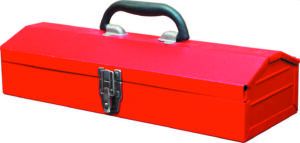
IN CASE OF FIRE
The FAA is adamant that an overheating or smoking device in the open (not in a bag or containment box) should not be moved, even to a containment bag, as moving it can trigger fire and jetting flames. In summary:
•Move passengers away.
• Use fire extinguishers to fight visible and surrounding fire. Do not move the device or attempt to remove the battery.
• Disconnect power if charging. If you cannot simply unplug, turn off the appropriate breaker.
• If there is smoke or fire, douse device with water to cool and prevent ignition of adjacent cells.
• If inside luggage . . . remove device from bag if safe to do so. Fight fire or overheat situation as described above.
• After fire is out, monitor for 10-15 minutes. Douse with additional water if smoke or fire appears. After that it is safe to move the device. Completely submerge in water; a pot, sink, or similar container. Lithium battery fire containment bags are acceptable; fill the bag with water.
• Finally, maintain a second fire exit for all below deck sleeping areas. Most have a hatch you can squeeze through. Make sure you can. Consider the Concepcion fire before you lash that dinghy over your foredeck hatch.
CONCLUSION
The risk of a power tool or cell phone fire is vanishingly small but not zero. Make sure your charging practices are up to snuff, don’t crowd charging around the companionway, don’t store power tools with the batteries installed, and guard the terminals of uninstalled batteries. This risk of this type of fire is easily mitigated.
Late last year, a cruising catamaran burnt to the waterline while sitting at the dock in Chubb Cay in the Bahamas. The cause, according to local witnesses, was a short in the rechargeable battery for an electric surfboard. The new generation of high-voltage battery- operated water toys that are ridden hard and put away wet have made it more important than ever that cruising sailors understand how to safely manage these batteries. We tracked down a few products that can help minimize the risk.
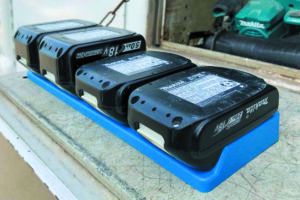
1. Makita makes a handy storage rack for its batteries, ensuring that the contacts are sealed and the batteries are secure.
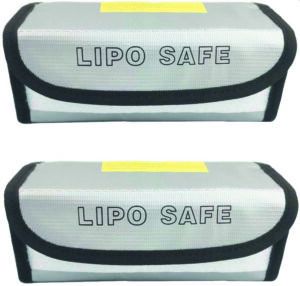
2. The LiPO Safe bag is designed prevent and contain fires that might result from overheating batteries.
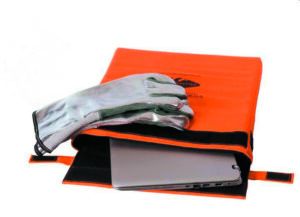
3. The Brimstone fire containment bag is designed to prevent fire from thermal runaway events.
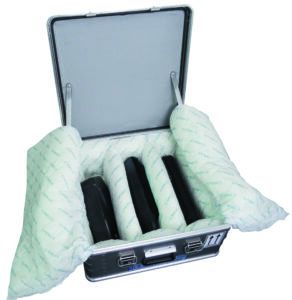
4. The Zargas Battery Safe is an aluminum case with a custom lining, that prevents ignition and extinguishes flames.
When a fire strikes at sea, you need to respond quickly, aggressively, and with a cool head, and you will not give up easily. At some point it is going to be prudent to leave the boat; serious burns will make survival in a raft difficult and gasoline and propane can explode. If the fire is well developed or started with an explosion, there may be time only for a quick Mayday call and to abandon ship.
FIRE FIGHTING ESSENTIALS
Every cruising boat should have at least the bare minimum required to fight an onboard fire:
• At least two fire extinguishers meeting the U.S. Coast Guard requirements.
• Fire blanket.
• Bucket weighted on one side to sink, with a rope handle.
FIGHTING A FIRE
Every fire is different but the aims are usually the same. The old firefighters acronym RECEO offers guidance: Rescue the victim, Eliminate exposed flammables, Contain the fire, Extinguish the fire, and Overhaul the area to make sure the fire is completely out and wont re-ignite.
If there has been an explosion, if the fire is well-developed, or if it is near gasoline or propane tanks, abandon ship quickly. Deploy the liferaft or dinghy if time allows, or grab a life vest and jump.
If you have hands to fight the fire while you man the helm, steer to minimize the effect of wind. If the fire is forward, slow down and head downwind to minimize the wind and keep the flames away from the cockpit.
Be prepared to shut off the engine, electrical system, and propane if any of these are source of fire, or making situation worse.
The first seconds matter. Ideally, you or a crew member would make a mayday or pan-pan call first, but you don’t want to lose precious seconds when the fire is still able to be contained. The call might have to wait.
If possible, hold one fire extinguisher in reserve so that after other methods, such as water, have been tried, the extinguisher is still available to mop up fire in confined spaces, or under the hull liner.
GALLEY FIRE
A fire extinguisher should NOT be your first reflex in a galley fire; once the extinguisher is discharged, you will be forced out of the cabin by toxic fumes and will not be able to finish fighting the fire, mop up embers, or confirm that it is out. If the fire is in a pan, put a lid on it. Do not use water on grease fires. To fight a fire in the oven, close the door. For fire in cabinets and liner, cover with fire blanket. Use water as applicable. Use a fire extinguisher for confined spaces.
ENGINE ROOM FIRE
Do not open the engine room door. The fire will feed on oxygen. A fire port should be available. Discharge one entire extinguisher into the space so that all air is displaced. Consider opening the cover to investigate, but position yourself behind the door in case it flares up. It may be best to wait a few minutes, or it may be better to immediately cool hot surfaces with copious water. Do not use water if there is a significant fuel leak.
CABIN FIRE
If fire cannot be put out, close all hatches and portholes, but leave escape hatches loose.
FIRE EXTINGUISHER
Practice on dry land a least once. Spray the base of the flames so that oxygen is cut off at the source; aim high and the fire will simply lift the agent. Remove the extinguisher from its bracket, pull the pin out of the extinguisher, and hold the unit upright. Stand about six feet back from the flames. You will be pushed back.
Work the edges. Reduce the fire area and then smother. You only have 20- 30 seconds before the extinguisher is spent. Get other crew to bring remaining fire extinguishers (but give explicit instruction to NOT use it yet), water buckets, and the fire blanket.
If all fails, abandon ship.
Do not risk serious burns. Have a crewmember position the raft or dinghy in the water where it will be safe from the flames and won’t get pinned to your boat. Do not wait until the very last minute. You need time for an orderly evacuation and a mayday call.
AFTER THE FLAMES ARE OUT
Fire extinguishers do not cool the embers and the fire may re-ignite. A fire is not out until it is cold. Water and wet towels are effective for cooling. A fire watch should be maintained for several hours. If you have not done so already, transmit a pan-pan call to the Coast Guard. It is always good to keep them informed so that they can respond more quickly.







































Another excellent article, thank you Darrell!